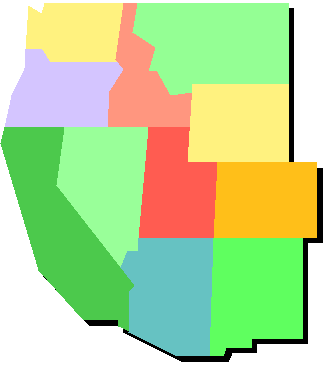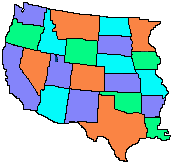The
American West
ITD Summer Institute, 2006
Schedule
Presentations Field Trips

As defined by the
Census Bureau, the western United States includes 13 states:
Alaska,
Arizona,
California,
Colorado,
Hawaii,
Idaho,
Montana,
New Mexico,
Nevada,
Oregon,
Utah,
Washington,
and Wyoming.

Other scholars define the West as the 22 states west of the Mississippi.
Geographical
Definitions of the American West
- "The West is the
United States west of the ninety-eighth meridian, a line passing through the
eastern Dakotas down the Great Plains through central Texas. ...[The West]
includes the entirety of that tier of states embracing the ninety-eight
meridian, including their eastern portions, since state boundaries do not
coincide with geographic boundaries and since it makes no sense to speak only of
the western and less populous portions of those states, states that are truly a
part of the West."--
M. Malone and R. Etulain, The American West .
- "The American West is
that contiguous section of the continent west of the Missouri River acquired by
the United States beginning with the Lousiana Purchase of 1803; continuing
through the acquisition of Texas, the Oregon Territory, and the Mexican Cession
in the 1840s; and ending with the 1854 Gadsen Purchase of the lands between the
Gila River and the present Mexican boundary"--
Richard White, It's Your Misfortune and None of
My Own.
- "...The West, which
stretches from around the ninety-eight meridian to the Pacific, and from the
forty-ninth parallel to the Mexican border, is actually half a dozen subregions
as different from one another as the Olympic rain forest if from Utah's
slickrock country, or Seattle from Santa Fe."Wallace Stegner, Where the Bluebeard Sings to the Lemonade Springs
.
- "The West is a
semi-desert with a desert heart."--Walter Prescott Web
- "[The West] is a
region with flexible borders at
the Pacific and at the hundredth meridian, where
rainfall drops below the twenty inches a year
needed to sustain irrigated agriculture." --Patricia Limerick,
Something in the
Soil.
-
"The West...begins with the Dakotas, Nebraska, Kansas, Oklahoma, and Texas. So
defined, the West would become, along with the North and the South, one of the
three great geographical regions of the...United States."--Donald Worster, "New West, True West"
Patricia Nelson Limerick, one of the leading
"new Western" historians admits that the West
is not "a unit of homogeneity and internal consistency," but that much of the
territory shares common characteristics. We will use her list of characteristics
which defines the West as a region as the units of
study:
- The West contains the bulk of the land still
under federal control--and is a case study in how the U.S. conducts conquest.
- The West is characterized by long involvement with the commercial, intentional
mythologizing of the region as a place of escape and adventure. The
population of the country is shifting to this region.
- In the West are the majority of American Indian reservations and Indian people.
- The West is part of the Pacific Rim and shares
a border with Mexico--much of the West was once under the sovereignty of
Mexico.
- The West has a particularly dramatic and
long-term involvement with boom/bust economies of extractive industries.
- The West is arid and semi-arid--which has inspired
many campaigns to
"normalize" this landscape.
- The West is the nation's dumping ground--for
people (Japanese Relocation Camps), for waste (Nuclear Test Sites).
|
Topic |
Presenters |
Activities |
Recommended Readings:
Internet Resources:


